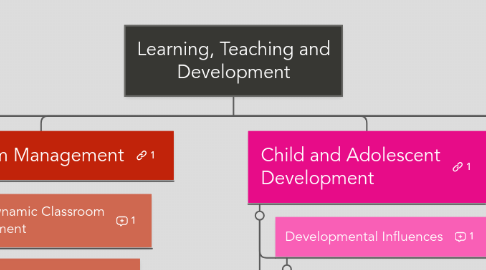
1. Educational Psychology
1.1. Schwab's Common Places of Education
1.1.1. Naive Perspective 1: Teacher x Subject
1.1.2. Naive Perspective 2: Teacher x Student
1.2. Research In Educational Psychology
1.2.1. Methods
1.2.2. Approaches to Research
1.2.2.1. Quantitative Research
1.2.2.2. Qualitative Ressearch
2. Teacher Planning
2.1. Teacher Instructional/Curricular Planning
2.1.1. Learning Objectives and Lesson Plans
2.1.2. Refer to 'Teaching Approaches'
2.1.3. Backward Design
2.1.4. Bloom's Taxonomy
2.1.5. Top-Down Approach
2.1.6. Stiggins's Achievement Targets
3. Teaching Approaches
3.1. Teacher-Centered
3.1.1. Direct Instruction
3.2. Student-Centered
3.2.1. Constructivism
3.2.1.1. Self-Regulated Learning (SRL)
3.2.2. Problem, Project, Inquiry Based Learning
3.2.3. Universal Instructional Design (UID)
3.2.4. Cognitive Strategies
4. Classroom Management
4.1. DCM: Dynamic Classroom Management
4.2. Process-outcome research
4.2.1. Employee
4.2.2. Employee
4.3. Goldstein and Brooks Tips on Diminshing Student Behaviour Problems
4.3.1. Employee
4.3.2. Employee
4.4. Deci's Tips to Nurture Three Fundamental Student Needs
5. Child and Adolescent Development
5.1. Developmental Influences
5.1.1. Physical/Biological Development
5.1.2. Cognitive/Learning Development
5.1.2.1. executive cognitive functioning
5.1.2.2. metacognition
5.1.2.3. Innate Curiosity
5.1.2.4. Innate drive to organize and adjust/constant search for equilibrium
5.1.2.5. Vygotsky: Zone of Proximal Development and Scaffolding
5.1.3. Language Development
5.1.4. Personal and Social Development
5.1.5. Moral Development
5.2. Societal Influences
5.2.1. Ecological Theory
6. Assessments
6.1. Diagnostic
6.2. Formative
6.3. Summative
6.4. Homework
6.5. Design Process
7. Intelligence
7.1. Caroll's Hierarchical Model of intelligence
7.2. Gardner's Theory of Multiple Intelligences
7.3. Sterberg's Triarchic Theory of Human Intelligence
7.4. Special Education
7.4.1. Students with ADHD
7.4.2. Students with ASD (Autism Spectrum Disorder)
7.4.3. Students who are Gifted and Talented
7.4.4. Students with Mild Intellectual Disability
7.4.5. Students with Specific Learning Disorders
